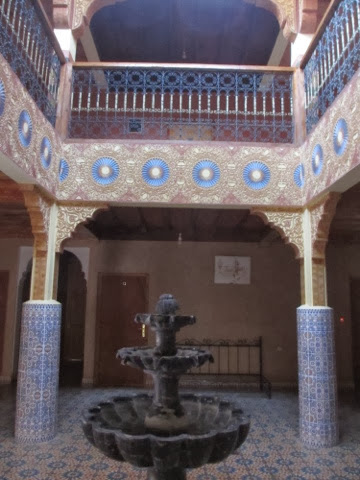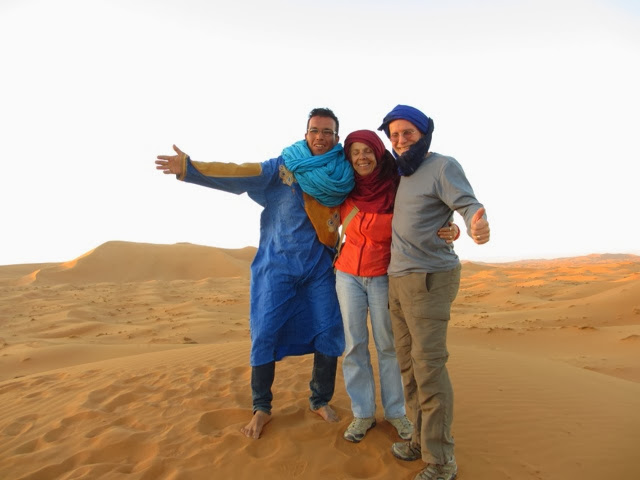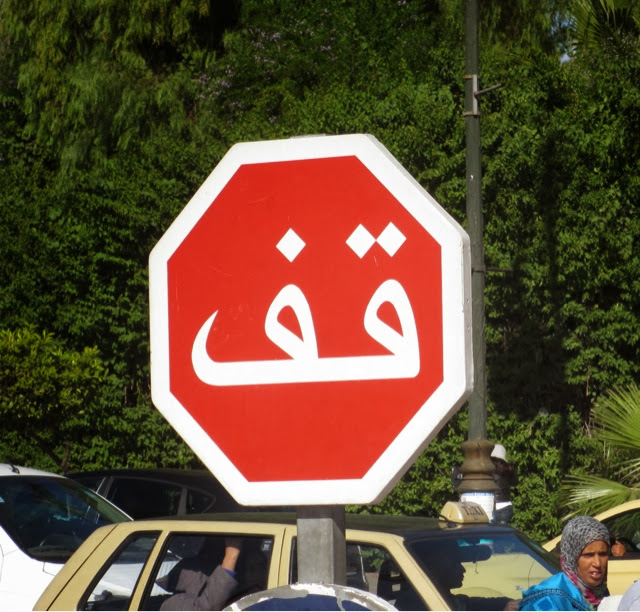Morocco -
For us, it's a new culture, a new language and a new currency... very little to anything we are familiar with in our developed U. S. Country...exciting, a little scary, but full of energy that is amazing and irresistible...
___________________________________________________________________
We've checked into our room at the Riad Argan. The idea of a Riad is to have a space in your home for guests to feel and experience the culture. It gives quite the authentic perspective a hotel could not offer.
Our room is the double door on the second floor.
The living room...warm mint tea was waiting for us when we arrived.
The common area is a courtyard in the middle of the Riad with a canvas retractable roof. On days such as today, with the sun shining and temperature around 70 degrees, we can look up from our breakfast table, 3 floors up to the sky. We also had one of our breakfasts in a courtyard on the roof, which has canvas awnings to protect from the hot sun.
The inside dining area...
Kasbah Amridil is a castle or a fortress of the 17th century. The picture of the Kasbah Amridil is on the bank notes of 50 Dirhams. It is the kasbah where famous movies were filmed, such as "Ali Baba and the 40 thieves" and "Lawrence of Arabia".
Kasbah typically refers to a walled town with many narrow maze-like streets. It is also called a Medina, which simply means "city" or "town" in modern day Arabic.
___________________________________________________________________
There are mosques all over the country. This is just one in a small village on the way to the Sahara Desert. 98% of the country is Muslim, 1% Christian and 1% other. As explained to us, even though there is quite a large population of Muslim, it seems most people identify themselves only as such, but do not always practice. It seems more of an age-old culture than a religion.
The tower shape of the mosque is much like a church, with bells in the bell tower. Prayers are announced (sung in monotone) from the top of the bell tower. Today the mosques have PA system type speakers at the top so that the prayers can be heard all around. The towers are now more of an iconic architectural design rather than something necessary for hearing the call.
There are 5 prayer times per day, all of which are broadcast through the loud speakers on top of the towers: 1) One hour before sunrise; 2) When the sun is directly above at 90 degrees (about noon); 3) When the sun is at 45 degree; 4) Sunset; and 5) One hour after sunset. The experience of hearing a sound that has been in existence for thousands of years is comforting as well as surreal..and is still continuing to this day. We felt privileged to have this experience.
___________________________________________________________________
There are two mountain ranges in Morocco, the High Atlas and the Anti Atlas Mountains, which run generally north and south. Although the entire country seems arid, as we crossed over the Tichka Pass to the east side of the High Atlas, we entered a much dryer area, the Sahara Desert. In the distance we could see the Anti Atlas (a lower range).
___________________________________________________________________
Our lodging is at the Riad Tabotihte, about 235 miles east of Marrakech. It's the end of our first day and our guide, Jalil, has been driving us toward the Saraha Desert where we will be tomorrow night. We just finished a traditional Moroccan Tajine dinner and we now hear traditional live Moroccan music outside our window.
Out for a hike through some of the local farm land and small villages, we ran across a typical irrigation trough used throughout the oasis. The water supply flows from the Atlas Mountains.
Part of the irrigation system to distribute water in the oasis...
We stopped in a village to see some of the handicrafts of the local Bedowin women making carpets. The woman in this picture is Bedowin. The Bedowin tribe is the heart of the Arab peoples. Women have a very important role in the Bedowin society. Not only do they raise the children, herd the sheep, milk the animals, cook and make the clothes, they also weave the cloth that makes the Bedowin Tent in which the family lives.
We do not have a photo of the tent but found it very interesting and wanted to share the history. Although to visitors the tent may not look suitable for desert living, it is the most versatile way to live in the desert. It can be packed away and ready to move within an hour. Because it is woven from goat or camel hair, it is waterproof. As the hair gets wet, it expands and becomes water tight. Amazing!
More sights on our hike - a family doing the laundry...
Morocco is the 4th largest olive producer in the world. Their goal is to be number 1. It's now olive harvest season and as we walked through some gardens and small farming plots, we saw lots of olives being harvested - and lots on the ground. Olives with every meal...
___________________________________________________________________
The Todra Gorge is a canyon in the eastern part of the High Atlas Mountains near the town of Tinerhir. The rock sides have many uneven surfaces and is popular among rock climbers. More than 150 routes, Grade 5+ to 8 are in the canyon...probably a climber's heaven.
Nomads can be seen with their small donkeys or herding camels and goats. They come down from the mountains during the day, and return to the mountains by nightfall.
The Nomadic Tribes once traveled the Desert in great numbers, but after invasions and wars, they have been reduced to small groups, scattered across the sandy hills of the the unforgiving Desert.
The Nomadic Desert people are sometimes called the Blue Men of the Sahara Desert. They traditionally wear blue turbans or dress. The blue comes from the indigo used to dye the cloth and rubs off on their skin. This terminology has been carried down through the centuries. The women do not wear this blue turban because they do not go out into the desert.
The nomad is a member of a group of people or tribe, usually living in tents, have no fixed home and move according to the seasons in search of food, water, and grazing land for their animals. Jalil told us there are less and less nomads, as many are moving to the nearby villages when possible to attain a better life.
Morocco has the largest population of the Berber tribe, which is the usual tribal description of the Nomads. The Berbers are known for their skills in various crafts, including weaving and pottery, which is the main work of the women (you may have hears the term "Berber carpet"). The men do most of farming and herding.
___________________________________________________________________
Many of the villages are along the roads and water sources. Although this is the Desert, there are oasis in many areas (we are not deep in the Saraha at this point). They get their water from the oasis and electricity from the power lines that run along the roads. Although we know there are Nomad villages in the mountains without power or water, on our trip we would not typically see villages too far from either water or the electric sources... all still quite primitive by developed world standards.
___________________________________________________________________
A Moroccan school bus...The safety mindset here isn't at all like the states. This vehicle was moving when we took this photo. - Don't fall out kids!
A couple of normal modes of transportation
___________________________________________________________________
We've reached the Western Sahara. On our way, we came to within 25 kilometers of Algeria. We decided to ride camels out to a Bedowin camp in the desert and stay the night. What a fun experience!
The Queen of Sheba in the orange on the camel with King Farouk getting his turban put on by Mousstafa, one of our camel guides.
King Farouk and Queen of Sheba riding Bob Marley and Einstein...
"Sometimes we wonder about these two..."
Great shadows cast in the desert...
The Microsoft wallpaper has nothing on us...
Looks like Einstein is yawning in the background.
Mousstafa - the guide for the camels.
There are three predominant tribes of Nomads in Morocco. The Berbers, the Bedowins and the Twali tribe. Mousstafa is a Berber, known by the blue turban (scarf) and tunic (clothing).
Mousstafa went to school until he was only 10 years old. He is the oldest son in his family and he explained that in living the life of a Nomad, continually moving around, one's age can nearly be doubled. He is now 25 years old but much like a 50 year old.
Many of the hotels and tour companies like to hire Nomads for the camel rides, as they have grown up with the animals. Our group had 8 people. His next group will be 29 people. Can you imagine...taking care of 29 camels?
Rest time...
Just before dark...
The crew entertained us with a show in the evening.
Entertainment is now at a whole new level.
___________________________________________________________________
We slept in the Bedowin camp. The tents were all made of carpets. Much like what you see above, the walls, floor, roof - even the doors were all carpets.
___________________________________________________________________
Getting prepared for the trek back to the hotel...
___________________________________________________________________
Once we left the desert we were in mountains formed by volcanic rock. We walked onto the rock, seeing fossils in many of the formations.
___________________________________________________________________
The Nomads typically survive by buying and selling animals. They always move around, finding new grazing land for their animals.
___________________________________________________________________
A village in the distance on an oasis...
An oasis, Hollywood style, is a small grouping (maybe a dozen) of Palm trees in the middle of the sand. This could be a typical (real) oasis in the foreground of the village up against the desert mountains in the distance. An oasis can be known to stretch as far as 200 kilometers...
___________________________________________________________________
The typical Moroccan dish is cooked in a Tajine (tah-jean). We enjoyed several delicious, slow cooked meals--Moroccan style.
___________________________________________________________________
This is one of a series of mountains we drove through known as "God's Fingerprint".
Desert mountains in the distance...
___________________________________________________________________
More Nomads grazing their animals... This white camel is a rare sight.
Look closely at the side of this incredibly steep mountain. You can see 4 goats who, with the greatest of ease, move from one pasture to another by way of traversing this steep mountain.
___________________________________________________________________
By chance we ran into a festival representing different tribes. We're not completely sure why they were having the festival, but we stayed around to see the different dress for the different tribes.
___________________________________________________________________
Sunset from our room just outside of the Western Sahara...
We enjoyed some Moroccan wine - quite good.
___________________________________________________________________
Kasbah ait Benhaddou has been a UNESCO World Heritage Site since 1987. Several films have been shot here including "Jesus of Nazareth", "Jewel of the Nile", "The Living Daylights", "The Last Temptation of Christ" and "Gladiaor".
There are artisans in the Kasbah... this fellow who had a unique form of art. He did his drawing with tea water and a bit of sugar. When the drawing was complete, it was very light on the paper. When we first saw it, we thought "that's nice but too light to appreciate". He then put the paper over his burner, as if burning the paper, and much to our surprise, only the tea got darker. It was quite amazing.
The Kasbah was high on a hill. It was quite windy and starting to get cold here in the High Atlas Mountains.
Mohamed, our guide through the Kasbah...Quite the happy fellow.
...and a bit of a "cut up"...quite fun as a guide.
On our way down from the Kasbah, we came into a small dust storm.
___________________________________________________________________
Marrakech.
Two cities in one. Driving in from the desert we first hit the new city, somewhat cosmopolitan, with all the normal things any major city would have (except the Hard Rock, which will be completed next year:) ). The second part of the city is old city called the Medina, that has been in existence since 1122-1123.
In the new city, this is a typical cell tower. Although AT&T, nor any of the US companies, have agreements here, there is cell service virtually everywhere for the locals. Our tour guide even had service in some of the canyons of the High Atlas Mountains.
KFC on the left - "Chicken of Kentucky" on the right...
___________________________________________________________________
We can't say enough about Jalil, both as a guide and a person. Interestingly enough,Jalil lived in Clearwater for 10 years up until about 5 years ago. He was the Receiving Manager at the Clearwater Lowes. He's now a guide for mostly English speaking folks and tours all over Morocco. Besides a great tour, we had a great time talking about Florida, good Moroccan restaurants, and his love of cooking. By the way, Jalil shared some great Morrocan dish ideas from him! We will definitely stay in touch, as he is now our friend.
___________________________________________________________________
Jamaa el Fna market is a square and market place in Marrakesh's Medina quarter (old city) that is known world wide. This is actually not a central market as we know it. It is a series (more like a maze) of interconnected markets specializing in many different things, and all prices are expected to be negotiated. Everything here and throughout the Medina appears centuries old with no signs of modern day advancements.
The market was so immense and such a maze that there was no way to photograph the experience. Booth after booth had jewelry, leather goods, clothing, food, spices and nearly anything else one could imagine. The colors, the sounds, the smells.... the whole experience was quite incredible.
Some of the most fun and visual things were the spices.
___________________________________________________________________
Stop?
___________________________________________________________________
A major sight in Marrakech is the Jamaa el Fna Markets, as we mentioned above. Jalil told us about the place where the Artisans have a coop that's set up in order to sell their work (without such a chaotic environment as the Jamaa el Fna). We met this metal Artisan and he assisted us as we viewed his work.
A piece we purchased, handmade by the artist...
The hamsa, also romanized khamsa, (meaning "five") is popular throughout the Middle East and North Africa. It depicts the open right hand, an image recognized and used as a sign of protection in many societies throughout history. The hamsa is believed to provide defense against the evil eye and predates Christianity and Islam.
___________________________________________________________________
We enjoyed good Moroccan beer.
___________________________________________________________________
___________________________________________________________________
Our overall experience of Morocco was great. It is such a contrast from our normal way of life, yet gives us a good sense of the contrasts in humanity. Although haggling over a price at the market is most common, we always felt quite welcomed and never over pressured to purchase something that wasn't right for us. No matter how foreign and crazy it seems to us, they seem like happy people. It gave us a good appreciation that we, in developed nations, are not necessarily the center of everyone's world. What a crazy and wonderful experience!










































































